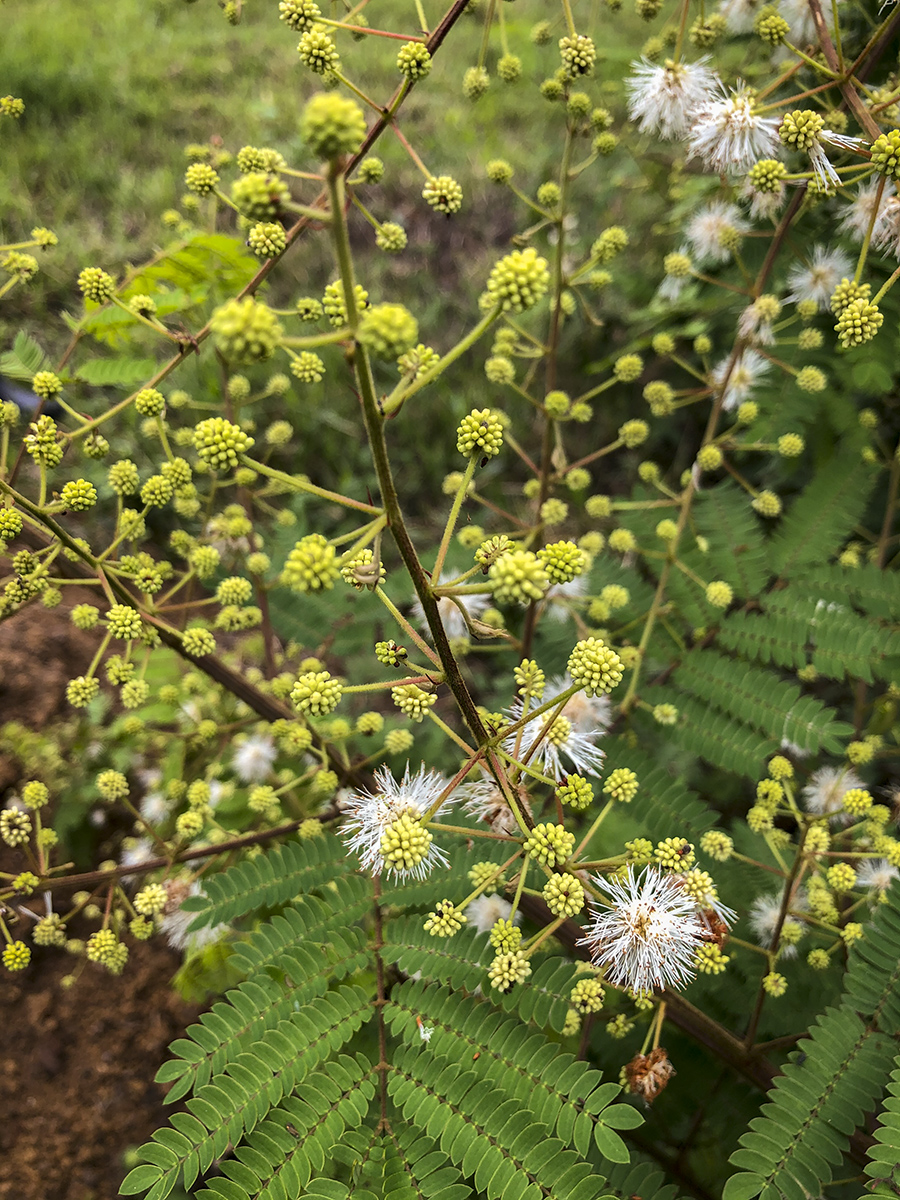Leucaena leucocephala, mimosa flower. Savannah (Dic 2, 2019) Photography by: Vivian Hurtado (IPhone).
Species description and general information
Leucaena leucocephala is a tropical multipurpose and one of the fastest growing leguminous trees belonging to the family Mimosaceae (Sethi and Kulkarni, 1995). Central America and Southeast Asia’s genus, Leucaena, contains approximately 50 species of both trees and shrubs. This species is a thornlees long-lived tree that may grow up to 7-18 m. Its leaves are bipinnate and the inflorescence has a cream colored globular shape which produces a cluster of flat brown pods 13-18 mm long that contain 15-30 seeds (Shelton and Brewbaker, 1994). L. leucocephala is the best-known species of the Leucaena genus and has a variety of common names (see Taxonomy). There are at least 14 other species recognized in the genus.
This species is originally from Mesoamerica, specifically from southern Mexico, Yucatan. It extends from Mexico to Nicaragua, including Guatemala, Honduras and El Salvador. With time, it was introduced to Indonesia, Malaysia, Papua New Guinea and Southeast Asia (CONABIO, 2013). Mesoamerica has been the origin of numerous domesticated plants and many of them are important sources of food and other human needs, including this species (Delgado et al., 2004).
Taxonomy
| Order | Fabales |
| Family | Fabaceae |
| Genus | Leucaena |
| Species | Leucaena leucocephala |
| Common name | Guaje, Petai, Katin, Ipil ipil, Waaxim (Maya), Huaxim (Yucatán) |
Uses of the species
L. leucocephala is known as a “miracle tree” because of its worldwide success as a long-lived and highly nutritious forage tree, used as firewood, timber, human food, green manure, shade and erosion control (Zayed and Samling, 2016).
Almost every part of L. leucocephala is consumed as human food since the era of the Mayans. In Indonesia, Thailand, and Central America its foliage is used as animal feed, and people eat the young leaves, flowers, and young pods in soups (Zayed and Samling, 2016; Sethi and Kulkarni, 1995). it is also one of the medicinal plants used to control stomachache, like contraception and abortifacient (Zayed and Samling, 2016). A study from Zayed and Samling in 2016 revealed the species possess various biological activities such as antioxidant, antimicrobial, hepatoprotective, antiparasitic, insecticide, pesticide, antiarthritic, antiandrogenic, hypocholesterolemic, cancer preventive, anti-cancer, analgesic and anesthetic.
Even though this plant has a lot of uses and nutrition properties, it’s also home for a strong toxic protein called mimosine that causes alopecia, growth retardation, cataract, etc. (Sethi and Kulkarni, 1995). There have been several studies and tests to detoxify this protein so we can all benefit from L. leucocephala.
The potential of L. leucocephala as an erosion control plant has been investigated in terms of its capacity of root reinforcement and root shear strength. The species exhibits extensive, dense rooting and depth of penetration. These aspects, could provide surficial as well as deep-seated erosion control (Normaniza et al., 2007).
Below is a selected bibliography for you to learn more about the species and how to identify it.
References Cited and Suggested Reading on Leucaena leucocephala
- 2004
- Crop Domestication in Mesoamerica. In Encyclopedia of Plants and Crop Science of Goodman, R.
Read Online:
https://books.google.es/books?hl=es&lr=&id=x5G3DwAAQBAJ&oi=fnd&pg=PA310&dq
=Leucaena+leucocephala+mesoamerica&ots=B9t8TrrL2q&sig=QaNFAwHWskVLtQ7W
UPVnIivfA44#v=onepage&q=Leucaena%20leucocephala%20mesoamerica&f=false
- 2020
- Potential use of Leucaena leucocephala Lam (leucaena) present in agroforestry systems of Pinar del Río. Revista Cubana de Ciencias Forestales, Vol. 8, Num. 1, pages: 154-162.
Download Online:
http://scielo.sld.cu/pdf/cfp/v8n1/2310-3469-cfp-8-01-154.pdf
- 2013
- Leucaena leucocephala (Lam.) – Mimosaceae. CONABIO
Download Online:
www.conabio.gob.mx/conocimiento/info_especies/arboles/doctos/44-legum26m.pdf
- 1989
- Leucaena leucocephala in poultry nutrition - A review. Animal Feed Science and Technology, Vol 26, Num. 1–2, 28 pages. https://doi.org/10.1016/0377-8401(89)90003-5
Download Online:
www.conabio.gob.mx/conocimiento/info_especies/arboles/doctos/44-legum26m.pdf
- 1996
- The nutritive value and forage productivity of Leucaena leucocephala. Animal Feed Science and Technology, Vol. 60, Num. 1–2, pages: 29–41. https://doi.org/10.1016/0377-8401(95)00922-1
Download Online:
www.sciencedirect.com/science/article/abs/pii/0377840195009221
- 2006
- Homegardens of Mesoamerica: Biodiversity, food security, and nutrient management. In Tropical Homegardens: A Time-Tested Example of Sustainable Agroforestry (pp. 61–84). https://doi.org/10.1007/978-1-4020-4948-4_5
Download Online:
https://link.springer.com/chapter/10.1007/978-1-4020-4948-4_5?noAccess=true#citeas
- 1994
- Leucaena: Promising Forage and Tree Crop for the Tropics. Report of an ad hoc panel of the Advisory Committee on Technology Innovation, Board on Science and Technology for International Development Office of International affairs.
Download Online:
http://pdf.usaid.gov/pdf_docs/PNAAQ822.pdf
- 2007
- Engineering properties of Leucaena leucocephala for prevention of slope failure. Ecological Engineering, Vol. 2, pages: 215–221. https://doi.org/10.1016/j.ecoleng.2007.11.004
Download Online:
www.sciencedirect.com/science/article/abs/pii/S0925857407002091
- 1995
- Leucaena leucocephala a Nutrition Profile. Food and Nutrition Bulletin, Vol. 16, Num. 13, 16 pages. https://doi.org/10.1177/156482659501600307
Download Online:
https://journals.sagepub.com/doi/pdf/10.1177/156482659501600307
- 1994
- Leucaena leucocephala – The Most Widely Used Forage Tree Legume. Agroforestería para la producción animal en Latinoamérica, Vol. 9, Num. 3, pages: 367-394.
This document has a detailed botanical description of the species including botanical illustrations of its leaves, seeds and inflorescence. It also includes a compilation of the species uses.
- 2016
- Phytochemical constituents of the leaves of Leucaena leucocephala from Malaysia. International Journal of Pharmacy and Pharmaceutical Sciences, Vol. 8, Num. 12, pages: 174–179. https://doi.org/10.22159/ijpps.2016v8i12.11582
This article has important information about L. leucocephala and it’s medicinal properties.
Suggested websites for Leucaena leucocephala
www.conabio.gob.mx/malezasdemexico/mimosaceae/leucaena-leucocephala/fichas/ficha.htm
Data sheet of the species and links to sites with information on taxonomy and nomenclature.
www.arbolesornamentales.es/Leucaenaleucocephala.htm
Description of the species, pictures and uses.
First posted November, 2022.
Written by María José Toralla














































































